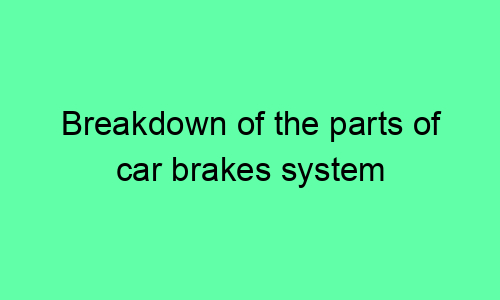Breakdown of the Parts of a Car Brakes System
Master Cylinder
The master cylinder is the heart of the braking system. It converts the force you apply to the brake pedal into hydraulic pressure. This pressure is then sent through the brake lines to the calipers and wheel cylinders.
Brake Lines
The brake lines are the tubes that carry the hydraulic pressure from the master cylinder to the calipers and wheel cylinders. They are typically made of steel or copper.
Calipers
The calipers are located on the wheels and contain the brake pads. When you apply pressure to the brake pedal, the master cylinder sends hydraulic pressure to the calipers. This pressure forces the brake pads against the rotors, which slows down the wheels.
Wheel Cylinders
The wheel cylinders are located on the rear wheels and contain the brake shoes. When you apply pressure to the brake pedal, the master cylinder sends hydraulic pressure to the wheel cylinders. This pressure forces the brake shoes against the drums, which slows down the wheels.
Brake Pads
The brake pads are the friction material that is pressed against the rotors or drums to slow down the wheels. Brake pads are typically made of a composite material that includes asbestos, metal, and rubber.
Brake Shoes
The brake shoes are the friction material that is pressed against the drums to slow down the wheels. Brake shoes are typically made of a composite material that includes asbestos, metal, and rubber.
Rotors
The rotors are the metal discs that are attached to the wheels. The brake pads press against the rotors to slow down the wheels.
Drums
The drums are the metal cylinders that are attached to the wheels. The brake shoes press against the drums to slow down the wheels.
Parking Brake
The parking brake is a separate braking system that is used to keep the car from rolling when it is parked. The parking brake is typically engaged by pulling on a lever or pushing a button.
Brake Fluid
Brake fluid is the hydraulic fluid that is used to transmit pressure from the master cylinder to the calipers and wheel cylinders. Brake fluid is typically glycol-based and contains additives to prevent corrosion and lubricate the brake system.
Brake Booster
The brake booster is a device that helps to amplify the force you apply to the brake pedal. The brake booster is typically vacuum-powered and is located under the hood.
Anti-Lock Brakes (ABS)
Anti-lock brakes are a safety feature that prevents the wheels from locking up during braking. ABS works by monitoring the speed of each wheel and reducing brake pressure to the wheels that are about to lock up.
Conclusion
The braking system is a critical safety feature in a car. It is important to understand the different parts of the braking system and how they work together to slow down and stop the car.






